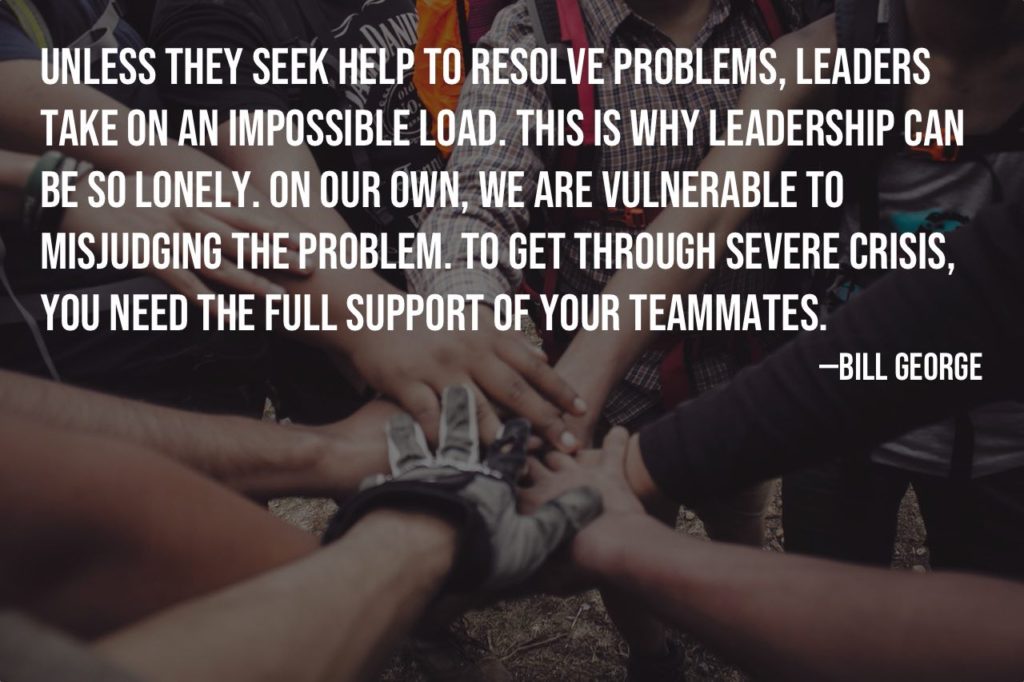
When times get difficult, leaders tend to take on burdens greater than they can carry alone. But, this is an impossible situation. In order to achieve anything great in an organization, you need a team to help you get there.
Here are five ways to enable your team to help you achieve your organization’s goals.
1) Create a Foundation of Trust Among Team Members
This, of course, starts with you. To foster trust, go first in difficult discussions. This can leave you vulnerable, but vulnerability, Brené Brown points out, “is the birthplace of innovation, creativity and change.”1
It takes great courage to move out of your comfort zone and bring difficult behavioral issues—your teammates and your own—to the surface. Unwilling to engage in office politics or posturing, leaders call out passive-aggressive behavior and people’s fear of conflict.
2) Act With Humility
Jim Collins highlighted personal humility as one of two primary qualities of top-performing leaders (fierce resolve was the second).2 Leaders take responsibility for poor results. They never blame other people or external factors. This creates an environment of psychological safety, enabling team members to be more open and creative.
Exhibiting personal humility means focusing on the contributions of others, not your own. Leaders move people with inspired standards.
3) Focus on Strengths, Pay Attention to Weaknesses
Leaders identify and play to team members’ strengths. When individuals play to their strengths, they experience greater happiness and higher performance. Playing to strengths is the precursor to cultivating talent.
But weaknesses can’t be ignored. Mitigating individual weaknesses is one of the primary functions of a high-performance team. Be sure that your team members have complementary skills that cover individual blind spots.
4) Push for a Higher Standard
As a leader, your habits and behaviors in the workplace either inspire your team to elevate their standards or undermine your corporate goals. Your habits and overall behaviors are what everyone is watching—consciously and subconsciously. Your people are constantly learning what’s acceptable behavior and what’s not.
With an unwavering resolve to do what it takes to produce the best long-term results, you can inspire your organization to new levels of performance. By staying accountable to your word and keeping your team leaders accountable to their commitments, you can foster a team that coaches themselves to increasing levels of effectiveness.
5) Highlight the End Picture
In the final analysis, it is the ability of your team to achieve desired results that determines its overall effectiveness.
To keep everyone on a team focused on the wildly important goals amidst personality conflicts and office politics is a skill for which every leader has room for constant improvement. Effective teams focus on no more than two key results at a time.
Fives Areas for Continual Improvement
These reminders aren’t a checklist. They represent five areas of continual growth and development for leaders committed to improving their craft and accelerating the growth of their enterprise.
We leave you this weekend with the words of pastor and lecturer George Boardman the Younger: “The law of harvest is to reap more than you sow. Sow an act, and you reap a habit; sow a habit, and you reap a character; sow a character, and you reap a destiny.”3
_______________________
- Brené Brown, “The power of vulnerability,” TED.com. ↩
- Jim Collins, “Level 5 Leadership: The Triumph of Humility and Fierce Resolve,” Harvard Business Review, 2005. ↩
- George Boardman the Younger, Phinneys’ Calender, edited by Andrew Beers, 1878. ↩
